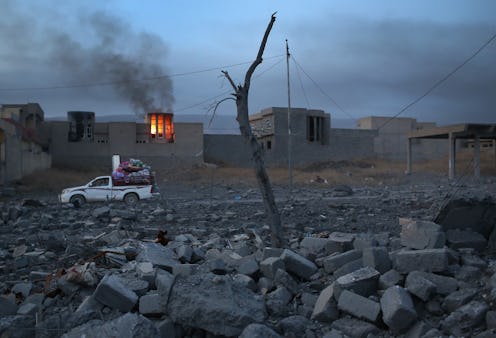Behind the curtain of modernity, historical monuments around the globe are actually in danger of disappearing before our eyes, thanks to vandalism, sectarian violence, development, and pollution. As various nations make technological strides forward and become more socially advanced, aged monuments stand as a vanguard of that initial progress and ancient finesse. Testaments to the evolution of civilization and art forms, they must emerge from the shadows of neglect so that they continue to inspire. A nonprofit organization called the World Monuments Fund helps repair decaying monuments and publishes a list of "at-risk cultural heritage sites" around the world.
In the release, President Bonnie Burnham explained the immense importance of keeping track of these sites and preserving them.
The 2016 Watch includes many extraordinary places that deserve to be celebrated because they represent high moments of human culture. Worldwide concern would strengthen our ability to save them. Every two year Watch cycle expands our knowledge about the state of the built environment worldwide, and the current challenges facing the preservation field.
Recently, much of the focus has been on religious landmarks, particularly those in the Middle East that have been destroyed by radical militant groups or have become vulnerable to looting after dictators were ousted. Syrian archaeologist Khaled al-Asaad, who had led excavations at a Syrian ruins site for decades, protected his nation's history by giving up his life to defend them against ISIS. His testament is e to the sanctity of cultural monuments around the world, like these ones that face a diverse variety of risks.
Mission San Xavier del Bac, Arizona
The eighteenth century Spanish Catholic Mission is open to the public and remains as an active church locally. Unnecessary repairs achieved more harm than good over the years and efforts to reverse the damage done are underway.
Abusir el-Malek, Egypt
Since the 2011 revolution when former president Hosni Mubarak was ousted, looting has become a major concern as thieves damage sarcophagi and break into pyramids as well as museums to retrieve items to sell in the black market. Abusir el-Malek is an Egyptian village with 500 acres of ancient ruins that date back centuries prior to the Arab Conquest. The artifacts being looted are removed incorrectly, suffer great damage, and go undocumented over the course of history.
Moseley Road Baths, United Kingdom
The Victorian age swimming pool closed to the public in 2003 after repair bills became too costly. Over the past decade, the building itself, which remains open, is decaying due to neglect and unsubstantial government funding. The building, which also features a library, was opened in 1907 and doubled as a hospital in World War II.
Kua Ruins, Tanzania
The ruins of a medieval Swahili village holds artifacts from other parts of the world, like China, that date back to the thirteenth century. The structures themselves have been damaged by extreme weather events, and because tourism in the area is unmonitored, they do not get repaired. Damage has also been done by looters digging for Swahili treasure.
Pavlopetri, Greece
At 5,000 years old, Pavlopetri is the oldest underwater archaeological site in the world. Its location was not discovered until 1967. The submerged city can be visited by anyone and no restrictions have been set. This leads to both pilfering and decay due to pollution and disturbances caused by large ships anchored nearby.
Dalieh of Raouche, Lebanon
The coastal neighborhood of Raouche has been open to the public for over 7,000 years. Archaeologists have excavated tools from the Neolithic age and the site also serves as one of the few "nature" destinations in Lebanon. The coast is unprotected by the government and vulnerable to over-development by real-estate moguls who have already bought up a majority of it.
Gon-Nila-Phuk Cave Temples and Fort, India
Tibetan Buddhism thrived in the Ladakh region of India during the tenth century. The caves, which feature Buddhist paintings, are in danger of collapsing due to the erosion of the mountainside. Only two caves remain open.
Chug-Chug Geoglyphs, Chile
The 1,000 year old geoglyphs, located in Chile's Atacama Desert, have been trampled by vehicles and are almost unrecognizable from an aerial point of view.
Mirador Ruins, Guatemala
Home to one of the world's largest pyramids, the Mayan ruins were abandoned a couple thousand years ago. The Mirador Basin — over 2,000 square miles of dense jungle — is vital in the study of ancient Mayan civilization and holds ancient roads and causeways. Mass deforestation, which has already destroyed parts of the ruins, threatens to do irreversible damage. On the other hand, the ruins are also being engulfed by the jungle itself.
Nineveh Ruins, Iraq
Nineveh, which prospered during the Assyrian empire and was once the largest city in the world, has become a victim of ISIS's destruction. The militant group bombed a 2,700 year old brick wall, raided nearby museums, and destroyed priceless artifacts that date back thousands of years.
Mahasthangarh, Bangladesh
These ruins date back thousands of years to the 3rd-century B.C. and contains the tomb of a Sultan who spread Islam to the region. The remains of Bangladesh's oldest city are frequently subject to thoughtless vandal and looting.
Church of Saint Gregory of Tigran Honents, Turkey
The Gothic style church, built on the border of Turkey and Armenia, is referred to as the cradle of medieval architecture. The city was settled in the 10th century, but abandoned in the 14th after the Turks forced the Armenians to leave. The ruins have remained unprotected.
Images: David Bacon/Flickr; Wikimedia Commons (1, 2, 3, 4)
